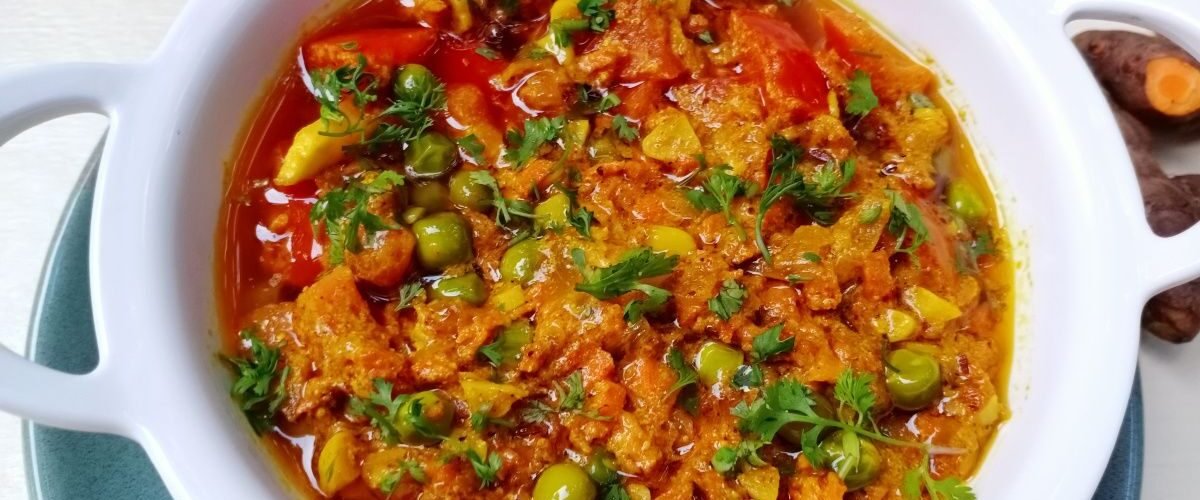Kacchi Haldi ki Sabzi: Reviewing the Hidden Gem Recipe of Rajasthan

Rajasthan celebrates winter with bold flavors, vibrant colors, and powerful ingredients. Among its many seasonal treasures, Kacchi Haldi ki Sabzi stands out as a dish that surprises every newcomer. Most people know turmeric only as a powdered spice that gives curries their golden hue. However, Rajasthan transforms fresh raw turmeric into a luxurious vegetable that tastes earthy, aromatic, and deeply comforting. Every spoonful brings warmth, nutrition, and a sense of heritage that reflects rural Rajasthan’s culinary wisdom.
The Cultural Soul Behind the Dish
Rajasthani households treat the winter season as an opportunity to strengthen the body. Families prepare dishes that energize, protect, and heal. Kacchi Haldi ki Sabzi fits perfectly into this philosophy. Raw turmeric grows abundantly during winter, so villagers harvest it fresh and create a dish that combines flavor with therapeutic value. Mothers and grandmothers prepare it with love, and they pass the recipe down through generations.
Traditional cooks treat this dish almost like medicine and food blended into one. They believe raw turmeric improves immunity, supports digestion, and boosts warmth in the body. When you eat this sabzi on a cold desert evening, you feel its heat spread through your system instantly.
Understanding Raw Turmeric
Raw turmeric looks like ginger but carries a deeper golden color and a sharper bite. When you slice or grate it, your fingers catch its vibrant yellow stain immediately. It smells earthy and slightly spicy. The flavor hits your palate with warmth and slight bitterness, but the right cooking technique transforms it beautifully.
Many people feel surprised when they hear that Rajasthan cooks it as a full sabzi. They expect overwhelming bitterness. However, the combination of curd, ghee, and mild spices balances the sharpness and creates a creamy, aromatic dish.
Ingredients That Build the Magic
Kacchi Haldi ki Sabzi includes simple ingredients, but each ingredient brings an important role:
- Fresh raw turmeric: The star of the dish. Fresh turmeric delivers heat, color, and strong medicinal value.
- Ghee: Rajasthani cooks rely on pure ghee to deepen flavor and improve the absorption of turmeric’s benefits.
- Curd: Curd cools the intensity of raw turmeric and forms a silky base.
- Gram flour (besan): Gram flour stabilizes the curd and prevents curdling.
- Spices: Cumin, asafoetida, red chili, coriander powder, and sometimes fennel add aroma and balance.
- Green peas or methi: Some households add peas or fresh fenugreek leaves for a sweeter or slightly bitter contrast.
No ingredient feels redundant. Every component softens turmeric’s raw punch and highlights its richness.
The Cooking Process
Rajasthani cooks grate the raw turmeric with care. They always protect their hands because the color grips the skin strongly. After grating the turmeric, they sauté it in generous ghee. The ghee mellows the sharpness and brings out a deep golden aroma.
Next, they whisk curd with gram flour to create a stable mixture. They pour this mixture into the pan slowly and stir continuously to maintain a smooth texture. The kitchen fills with a warm, earthy fragrance that feels instantly comforting.
The sabzi thickens gradually as the turmeric cooks further. The spices blend into the mixture, and the dish takes on a beautiful rich yellow color. Every step feels deliberate, slow, and soothing—almost like a winter ritual.
The Flavor Experience
Kacchi Haldi ki Sabzi tastes unlike any other Indian vegetable dish. The richness of ghee meets the raw pungency of turmeric and melts it into a creamy and slightly nutty preparation. The dish carries:
- Warmth: You feel heat spread through your throat and chest after each bite.
- Earthiness: The natural flavor of turmeric dominates but never overpowers.
- Creaminess: The curd mixture adds a smooth consistency that comforts the palate.
- Subtle sweetness or bitterness: Depending on whether the cook chooses peas or methi, the dish acquires a different dimension.
No artificial color enhances the dish. Turmeric offers its own brilliance. The texture feels rich but not heavy, and the aroma lingers long after the meal ends.
Serving the Sabzi the Traditional Way
Most Rajasthani families serve Kacchi Haldi ki Sabzi with bajra roti or missi roti. The coarse texture of millet or gram flour rotis pairs beautifully with the creamy turmeric base. Some households add jaggery on the side to provide sweetness, while others keep the meal entirely savory.
The dish usually appears during lunch because the body absorbs turmeric’s heat better during the day. Families often enjoy it with simple accompaniments like sliced onions, green chilies, and homemade pickles.
A Recipe That Honors the Body
Many winter dishes focus solely on indulgence, but this recipe merges pleasure with wellness. Raw turmeric supports immunity and metabolism. Ghee nourishes the body and improves joint mobility. Curd aids digestion and balances acidity. The spices stimulate appetite and protect the stomach from winter sluggishness.
Rajasthani elders praise this dish because it strengthens the body naturally. They encourage their children to eat it when the weather turns harsh. Many families rely on it as their winter defense without depending on packaged supplements.
Why the Dish Stays a Hidden Gem
The dish remains unknown outside Rajasthan for several reasons. Fresh turmeric does not stay available in all states throughout winter. Also, many people hesitate to cook with raw turmeric because they fear bitterness or staining. Restaurants rarely include this dish on their menus because tourists might not recognize it or appreciate its rustic charm.
However, those who taste it once always carry the memory with them. Food lovers often describe it as one of the most surprising regional dishes they discover in India.
Modern Appreciation and Revival
Food bloggers, home cooks, and culinary explorers now celebrate forgotten regional dishes. Many creators highlight traditional recipes that deserve national recognition. Kacchi Haldi ki Sabzi benefits immensely from this movement. Young Rajasthani chefs prepare it at food festivals. Home cooks record videos to showcase the process, and wellness enthusiasts praise its nutritional benefits.
Even though the dish maintains its rustic roots, modern kitchens embrace it with enthusiasm. People who follow natural healing or Ayurvedic diets now include it in their seasonal meals.
Conclusion
Kacchi Haldi ki Sabzi stands as more than a winter recipe. It represents cultural knowledge, seasonal wisdom, and culinary creativity. Rajasthan transforms a raw, potent ingredient into a dish that comforts, heals, and dazzles with simplicity. Every spoonful tells a story of tradition and resilience. If you enjoy exploring authentic Indian cuisine, this dish offers a rare and unforgettable experience. Try it once, and you will carry its golden warmth in your memory forever.
Also Read – Review of Lebanese and Middle Eastern Eateries













